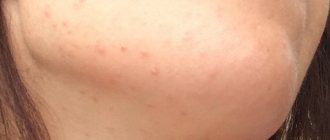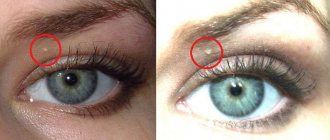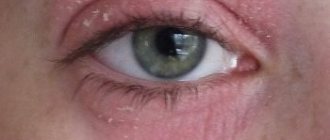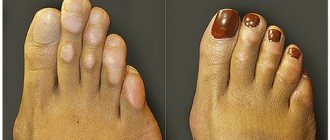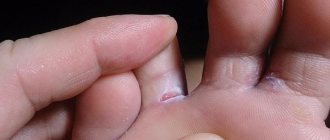The mammary gland consists of approximately 10 - 12 lobes. All of them should normally be grouped together in the chest area. An accessory lobule of the mammary gland is an atypical location of part of the glandular tissue of the organ. A woman may not know about its presence for many years, since it is not always accompanied by any clinical signs. What are the dangers of an additional lobe of the mammary gland and does it need to be removed?
Features of additional shares
Accessory lobe of mammary gland in the armpit
Polymastia, or an additional lobe of the mammary gland, is included in the ICD-10 classification and refers to congenital developmental anomalies that are associated with deformities and chromosomal abnormalities.
Polymastia is associated with an atypical position of the glandular tissue of the breast, most often indicating an additional lobe under the armpit.
Also, the breast lobule can be located between the mammary glands, directly under the collarbone or deep in the armpit. The most rare and remote cases of the position are outside the milky line, right between the shoulder blades or in the pelvic area.
What are extra breasts?
An additional mammary gland is the presence in an uncharacteristic place on the human body of an independent lobe or a lobe consisting of a glandular element or a full-fledged third mammary gland.
In this case, it is worth paying attention to the following nuances:
| State | Peculiarities |
| Extra slice | Under the skin there is only a glandular structure, but no nipple. |
| Polymastia | In an uncharacteristic area for the anatomy of the human body, there is a fully developed breast with an areola-nipple zone and milk ducts. According to ICD-10, the clinical condition was assigned code Q83.1. |
| False breast | Under the pathological nipple there is only one fatty component. |
| Polythelia | Only an atypical nipple or areola is observed without the presence of a glandular structure. |
An additional milk lobe occurs not only in the fairer sex - cases have been recorded when it was also found in men, however, in them a similar defect looks like an extra nipple and only in isolated cases was it found with developed glandular tissue, nipple and areola.
Features of the condition
The disease is characterized by:
- The abnormal gland is located in the area of the milk ducts, which extend from the armpits to the groin. True, doctors know of cases when it developed between real mammary glands, on the thigh and even in the popliteal fossa.
- In young children, such a formation is almost invisible and its presence is revealed only in adolescence, when hormonal changes occur, causing its increase.
- The third breast tends to swell before menstruation, sometimes inflammation and severe swelling of the glandular structure develop.
- Long-term hormonal disturbances or trauma to the pathological mammary gland can lead to the formation of cystic seals and tumors of a benign or oncological nature inside it.
Location of the gland on the body
As mentioned above, the excess lobe of the breast is located in the direction of the milk canals, the branching of which connects the armpit dimple with the groin area - under the natural physiological gland or in the armpit dimples, under the collarbone and in the femoral part.
Among other areas of the body where the disease can manifest itself, doctors call:
- Neck.
- Buttocks.
- Genital area.
- Middle back (shoulder blades).
If it is localized on the milk line, it usually has a normal structure, and in the presence of a nipple and milk canal, it is capable of producing breast milk.
Reasons for the formation of a false lobe
Among the factors influencing the formation of anomalies are the severe stress of a pregnant woman
The appearance of an additional lobule of mammary gland under the arm is most often associated with genetic abnormalities and disorders during embryonic development. There are no other confirmed causes for this condition. However, doctors often identify factors that may contribute to the anomaly:
- severe stress of a pregnant woman, as well as poor diet and bad habits;
- genetic mutation at week 6, when the most important parameters of adipose tissue are established;
- sharp changes in hormonal levels during adolescence in a woman who has an additional lobe;
- hereditary predisposition - risks increase to 90% if the woman’s mother or grandmother had polymastia.
A separate factor that can be identified is that a pregnant woman takes certain groups of medications that contribute to the development of pathology: anticonvulsants, contraceptives, drugs to reduce the activity of the thyroid gland, as well as medications to normalize blood clotting. Chemotherapy, ionizing radiation and radiation treatments for cancerous tumors are especially dangerous.
Intrauterine infections are a provoking factor in the development of abnormalities
Some household chemicals and industrial compounds with which a woman interacts can contribute to problems during pregnancy. Other factors cannot be ruled out:
- mental disorders of the expectant mother, frequent stress and emotional tension;
- chronic diseases;
- intrauterine infections;
- prolonged exposure to extremely low or high temperatures that do not correspond to the natural conditions to which a woman is accustomed;
- mechanical damage to the fetus in the 1st-3rd trimester after an accident, falls, blows.
Identifying these factors is a very complex process, since some of them may not be noticed by a woman or may not be assessed by her as dangerous.
Heart pathologies
With heart disease, chest pain radiates to the armpit. Irradiation of pain is directed to the left side, arm and lower jaw on the left.
© shutterstock
Causes
Painful discomfort under the armpit and in the chest is caused by pathologies accompanied by myocardial ischemia:
- IHD;
- heart attack
Both conditions are caused by impaired coronary blood flow and oxygen starvation of the heart muscle.
Signs
Symptoms of the ischemic process in the myocardium are:
- chest pain that improves when lying down or half-sitting;
- reduction or disappearance of pain discomfort after taking nitroglycerin;
- ineffectiveness of analgin and other traditional painkillers.
The primary detection of cardiac pathology is carried out using a cardiogram.
Treatment
Therapy depends on the nature and degree of ischemia. Mild or moderate forms of angina and coronary artery disease are treated with long-acting nitrates and symptomatic therapy.
Heart attacks and severe unstable angina are subject to hospitalization . In inpatient conditions, drugs are selected to restore coronary circulation and reduce the severity of the ischemic process in the heart muscle.
Who treats
For heart diseases, cardiologists provide assistance and select medications.
© shutterstock
Symptoms of the development of polymastia
With the development of mastopathy of the accessory lobe, a compaction is formed
If the accessory mammary gland is small in size, it will not manifest itself for a long time. The following conditions can provoke symptoms of additional lobules:
- Pregnancy. The lobe becomes rounded and becomes distinct even before the delay occurs. Under the influence of prolactin, the mammary glands are transformed, which also affects the additional elements. This can be noticed by swelling, discomfort and even pain in the armpit area.
- Childbirth and lactation. On the 5th day, a woman experiences maximum milk production, which leads to breast enlargement, increased density and sensitivity. The same thing happens with the extra slice.
- The occurrence of inflammatory processes. Inflammation may or may not be associated with the feeding process. Often inflammation - mastitis - manifests itself long before and after lactation. Outwardly, it looks like an enlarged lymph node - the formation is quite dense, localized in the middle of the armpit. But inflammation can also indicate another disorder - a cancerous tumor. In this case, the formation may not hurt in the initial stages; it will be mobile, independent of other tissues.
- Development of mastopathy. In the axillary area, pain occurs in the second phase of the menstrual cycle, but with the onset of menstruation, the discomfort goes away. In some patients with mastopathy of the accessory lobe, a small compaction forms.
The additional lobe that appears does not have additional symptoms, such as fever or effects on general well-being.
Health Hazard
If the appearance of an additional lobe of mammary gland under the arm is not associated with pain and unpleasant symptoms and it does not bother the woman in any way, there is no need to worry about the condition of the formation. In itself, it is not dangerous to health. The rate of growth into a malignant tumor is no greater than the formation of nodes in the normal mammary gland.
However, pathological processes in this part of the gland may be diagnosed too late, which will slow down treatment. It often turns out that it is possible to detect pathology even with an advanced abscess or stage 3-4 tumor. This can be avoided if you regularly undergo examinations by doctors - a gynecologist and a mammologist.
Neuropathies
A pinched or inflamed nerve in the shoulder or thoracic region leads to pain in the chest and armpit.
© shutterstock
Causes
Provoke neurological pathology:
- diseases of the spine;
- shoulder dislocation;
- bruises.
In some cases, the cause is vitamin deficiencies and some infections (chicken pox, measles).
Symptoms
The patient's main complaint is that the chest hurts in the armpit. The pain may radiate to the shoulder, back or ribs.
In addition to pain, a person may experience a tingling or numbness sensation under the armpit and nearby areas.
The mobility of the arm, where pain is felt under the armpit, is limited.
Treatment
Therapeutic measures are aimed at eliminating nerve irritations. For this use:
- anti-inflammatory drugs (tablets and ointments);
- NSAIDs;
- painkillers.
If the cause is a dislocation, then the shoulder joint is reduced.
Who will help
It depends on why the pain in the armpit occurred. If the cause is a dislocation, then you should visit a traumatologist, and if it is pinched or inflamed, you should visit a neurologist.
Diagnosis of the condition of the accessory lobe
Often an accessory mammary gland is detected during a comprehensive ultrasound examination
To make a diagnosis, doctors require precise instrumental examination techniques:
- Ultrasound. Very often, an additional lobe is found by chance during a comprehensive ultrasound.
- CT and MRI. They are used when a tumor is suspected and to clarify the nature of the tumor.
- Mammography. Allows targeted examination of the axillary and chest areas.
- Puncture. It is carried out for mastopathy and other signs of inflammatory processes to be sent for histological examination.
If there is a serious suspicion of cancer, a woman is prescribed blood tests to determine tumor markers.
It is impossible to diagnose an additional lobule of the mammary gland by visual examination and palpation alone. An experienced mammologist always prescribes an instrumental examination to accurately exclude unfavorable factors and pathological processes.
Need for surgery
Acute psychological discomfort or the presence of diseases in the additional lobule are indications for surgery
Treatment of the additional lobe of the mammary gland under the arm is possible only by removing the pathological formation: in the presence of cysts, tumors, abscesses. In other cases, doctors do not recommend touching the lobule if it causes purely aesthetic discomfort.
Indications for surgery will be:
- detection of cysts, malignant tumors and fibroadenomas;
- regular pain and swelling of unknown origin;
- large size of the accessory gland;
- acute psychological discomfort.
Sometimes therapy with drugs for mastopathy is prescribed if the symptoms appear rarely and are mild. These medications are good at relieving swelling, discomfort, and mild pain. Hormonal contraceptives are often used to eliminate signs of polymastia.
Estimated treatment prognosis
With proper surgery, the risk of complications is minimal, and doctors predict a favorable outcome of treatment. However, much depends on the severity of the pathological neoplasm. Basically, the therapeutic result is positive, but in some situations development may occur:
- Inflammation in the operated area.
- Scar formation.
- Manifestation of hematomas.
- Excessive skin pigmentation.
Regarding whether the accessory gland can reappear, its secondary formation is observed in cases where an incomplete excision of the lobe or breast was performed.
Methods for removing an additional lobe
Removed additional milk lobe
There are several methods for surgical removal of the accessory lobe of the mammary gland. The most common among them:
- Excision and suturing. Through an incision in the skin, the doctor removes the glandular tissue and the nipple, if present. The skin is then excised and the tissue is sutured. The removed tissue can be sent for biopsy to identify the causes of the formation of an additional lobule.
- Liposuction. During the operation, fat deposits are sucked out from the accessory lobule.
For up to 5 days after surgery, the doctor will install a drainage tube to prevent pus and other secretions from accumulating in the area. The recovery period takes on average 1 month.
Prevention and prognosis
A woman who has this anomaly genetically cannot prevent the formation of an additional lobule. This is due to the fact that reliable information about the causes of the disease has not been collected. However, to avoid the growth of glandular breast tissue during pregnancy, a woman needs to stop taking provoking medications, reduce stress levels and monitor her health to exclude infectious and viral lesions.
If a woman has developed an additional lobe, she needs to be examined every year with an ultrasound. After 35 years, it is necessary to undergo mammography every 6 months in order to exclude cancer processes. It is not recommended to injure this area, as injuries can cause inflammation.
The prognosis for control of the additional lobule is favorable. The appearance of a malignant tumor in it is the exception in medical practices rather than the rule. It is also noted that after menopause, some anomalies may disappear without surgical intervention.


